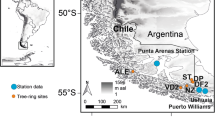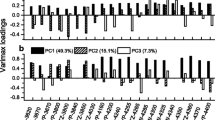Abstract
This paper explores the temporal stability of growth/climate relationships in ring-width chronologies of Norway spruce [ Picea abies (L.) Karst] and silver fir ( Abies alba Mill) in the Lower Bavarian Forest region in southern Germany. These chronologies were compiled, using both historic and living tree-ring data, with the main aim of developing a dendroclimatic reconstruction for the region covering the last 500 years. Moving window correlation analysis shows that prior to the twentieth century, both species co-vary in a similar way (1480–1899 mean r =0.66). There is no significant correlation between the species chronologies since ca. 1930, which partly reflects anomalous growth trends in the fir chronology since ca. 1960. Multiple regression analysis was utilised to assess the ability of both species chronologies to model March–August precipitation. The precipitation signal of the spruce data was found to be both stronger than the fir data (1872–1930 calibration: r 2=0.45 vs 0.25) and more time stable. After ca. 1930, the fir chronology loses it ability to model March–August precipitation until there is no climate signal at all in the fir data in recent decades. The spruce data also express a later weakening in their climate signal in the mid 1970s. We present compelling evidence indicating that the anomalous trends observed in the fir data, since the mid 1960s, appear to be predominantly related to local SO2 emissions from power plants and refineries. It is also likely that this local anthropogenic forcing is the cause of the weakening of the climate signal in the spruce data since the mid 1970s. The conclusions from this study are: (1) The fir tree-ring data cannot be used for traditional dendroclimatic calibration, although prior to the twentieth century the decadal variability in the fir data is very similar to spruce and so these data could be used to extend potential reconstructions in the future; (2) The recent decline and recovery event in the fir data appears to be unique to the twentieth century and is not part of a natural episodic phenomenon; (3) Traditional dendroclimatic calibration of March–August precipitation will be made using solely the spruce ring-width data. However, due to SO2 forcing in recent decades, the calibration period will be shortened to the 1871–1978 period.







Similar content being viewed by others
References
Baeriswyl P, Rebetez M (1997) Regionalisation of precipitation in Switzerland by means of principal component analysis. Theor Appl Climatol 58:31–41
Barber V, Juday GP, Finney B (2000) Reduced growth of Alaskan white spruce in the twentieth century from temperature-induced drought stress. Nature 405:668–673
Brázdil R (1992) Climatic conditions of the Little Ice Age in Bohemia. In: Mikami T (ed) Proceedings of the International Symposium on the Little Ice Age. Tokyo Metropolitan University, Tokyo
Brázdil R (1996) Reconstructions of past climate from historical sources in the Czech Lands. In: Jones PD, Bradley RS, Jouzel J (eds) Climatic variations and forcing mechanisms of the last 2000 years. Springer, Berlin Heidelberg New York
Brázdil R, Stepánková P, Kyncl T, Kyncl J (2002) Fir tree-ring reconstruction of March–July precipitation in southern Moravia (Czech Republic), A.D. 1376–1996. Climate Res 20:223–239
Briffa KR (2000) Annual climate variability in the Holocene: interpreting the message of ancient trees. Quat Sci Rev 19:87–105
Briffa KR, Jones PD (1990) Basic chronology statistics and assessment. In: Cook ER, Kairiukstis LA (eds) Methods of dendrochronology: applications in the environmental sciences. Kluwer Academic, Dordrecht, pp 137–152
Briffa KR, Schweingruber FH, Jones PD, Osborn TJ, Shiyatov SG, Vaganov EA (1998a) Reduced sensitivity of recent tree-growth to temperature at high northern latitudes. Nature 391:678–682
Briffa KR, Schweingruber FH, Jones PD, Osborn TJ, Harris IC, Shiyatov SG, Vaganov EA, Grudd H (1998b) Trees tell of past climates: but are they speaking less clearly today? Phil Trans R Soc London B 353:65–73
Briffa KR, Jones, PD, Schweingruber FH, Osborn TJ (1998c). Influence of volcanic eruptions on Northern Hemisphere summer temperature over the past 600 years. Nature 393:450–454
Cook ER, Peters K (1981) The smoothing spline: a new approach to standardizing forest interior tree-ring width series for dendroclimatic studies. Tree-Ring Bull 41:45–53
Cook ER, Peters K (1997) Calculating unbiased tree-ring indices for the study of climate and environmental change. Holocene 7:361–370
Cook ER, Briffa K, Shiyatov S, Mazepa V (1990) Tree-ring standardisation and growth-trend estimation. In: Cook ER, Kairiukstis LA (eds) Methods of dendrochronology: applications in the environmental sciences. Kluwer Academic, Dordrecht, pp 104–123
Cook ER, Briffa KR, Jones PD (1994) Spatial regression methods in dendroclimatology: a review and comparison of two techniques. Int J Climatol 14:379–402
Dittmar C, Elling W (1999) Jahrringbreite von Fichte und Buche in Abhaengigkeit von Witterung und Hoehenlage. Forstwiss Centralbl 118:251–270
Eckstein D, Sass U (1989) Dendroecological assessment of decline and recovery of fir and spruce in the Bavarian Forest. In: Bucher JB, Bucher-Wallin I (eds) Air pollution and forest decline. Proceedings of the 14th International Meeting for specialists in Air Pollution Effects on Forest Ecosystems. IUFRO P2.05, Interlaken, Switzerland, October 2–8, pp 255–260
Ellenberg H (1996) Vegetation Mitteleuropas mit den Alpen. 5. Aufl. Ulmer, Stuttgart, pp 376–378
Elling W (1990) Schädigungsverlauf und Schädigungsgrad von Hochlagen-Fichtenbestäden in Nordostbayern. Allg Forst Z 45:74–77
Elling W (1993) Immissionen im Ursachenkomplex von Tannenschädigung und Tannensterben. Allg Forst Z 48:87–95
Elling R (2000) Reaktionen der Tanne auf Belastung durch Schwefeldioxid an einem Beispiel im Raum Kelheim. Facharbeit Camerloher-Gymnasium, Freising
Elling W (2001) Emissions of power plants and growth of silver fir. In: Kaennel Dobbertin M, Bräker OU (eds) International Conference of Tree-Rings and People. Davos, 22–26 September 2001
Fritts HC (1976) Tree rings and climate. Academic, London
Fritts HC, Guiot J (1990) Methods of calibration, verification and reconstruction. In: Cook ER, Kairiukstis LA (eds) Methods of dendrochronology: applications in the environmental sciences. Kluwer Academic, Dordrecht, pp 163–217
Greve U, Eckstein D, Aniol RW, Scholz F (1987) Dendroklimatologische Untersuchungen an Fichten unterschiedlicher Immissionsbelastung in Nordostbayern. Allg Forst Jagdz 157:174–179
Herzog J, Müller-Westermeier G (1998) Homogenitätsprüfung und Homogenisierung klimatologischer Meßreihen im Deutschen Wetterdienst. Internal Report for German Weather Service (DWD)
Huber B (1970) Dendrochronology. Handb Mikrosk Techn 5:171–211
Jacoby GC, D' Arrigo R (1995) Tree ring width and density evidence of climatic and potential forest change in Alaska. Global Biogeochem Cycles 9:227–234
Jones PD, Hulme M (1996) Calculating regional climatic time series for temperature and precipitation: methods and illustrations. Int J Climatol 16:361–377
Kandler O (1992a) The German forest decline situation: A complex disease or a complex of diseases. In Manion PS, Lachance D (eds) Forest decline concepts. APS, St Paul, Minn.
Kandler O (1992b) No relationship between fir decline and air pollution in the Bavarian Forest. For Sci 38:866–869
Kandler O (1993) Development of the recent episode of Tannensterben (Fir decline) in Eastern Bavaria and the Bavarian Alps. In: Huettl R, Mueller-Dombois D (eds) Forest decline in the Atlantic and Pacific Region. Springer, Berlin Heidelberg New York, pp 216-226
Kohler MA (1949) Double-mass analysis for testing the consistency of records and for making adjustments. Bull Am Meteorol Soc 30:188–189
Lloyd AH, Fastie CL (2002) Spatial and temporal variability in the growth and climate response of treeline trees in Alaska. Climatic Change 52:481–509
Osborn TJ, Briffa KB, Jones PD (1997) Adjusting variance for sample size in tree-ring chronologies and other regional mean time series. Dendrochronologia 15:89–99
Pfister C (1992) Five centuries of little ice age climate in western Europe. In: Mikami T (ed) Proceedings of the International Symposium on the Little Ice Age. Tokyo Metropolitan University, Tokyo
Pfister C (1995) Monthly temperature and precipitation in Central Europe from 1525–1979: Quantifying documentary evidence on weather and its effects. In: Bradley RS, Jones PD (eds) Climate since AD 1500. Routledge, London
Riffeser L, Ambros M (2001) Kronenmerkmale und Jahrringuntersuchung von Fichte und Tanne unterhalb der Meßstelle Brotjacklriegl des Umweltbundesamtes. Diplomarbeit Fachhochschule Weihenstephan, 76 S
Sander C, Eckstein D, Kyncl J, Dobry J (1995) The growth of spruce ( Picea abies (L.) Karst.) in the Krkonose-(Giant) Mountain as indicated by ring width and wood density. Ann Sci For 52:401–410
Vaganov EA, Hughes MK, Kirdyanov AV, Schweingruber FH, Silkin PP (1999) Influence of snowfall and melt timing on tree growth in subarctic Eurasia. Nature 400:149–151
Visser H, Molenaar J (1992a) Estimating trends and stochastic response functions in dendroecology with an application to fir decline. For Sci 38:221–234
Visser H, Molenaar J (1992b) Air pollution stress in the Bavarian Forest. For Sci 38:870–872
Wentzel KF (1980) Weisstanne = immisionsempfindlichste einheimische Baumart. Allg Forst 35:373–374
Wigley TML, Briffa KR, Jones PD (1984) On the average of correlated time series, with applications in dendroclimatology and hydrometeorology. J Climate Appl Meteorol 23:201–213
Wilson RJS (2003) Assessment of historical tree-ring material for dendroclimatic purposes in the Bavarian Forest, Germany. PhD thesis, University of Western Ontario, Canada
Wilson RJS, Hopfmueller M (2001) Dendrochronological investigations of Norway spruce along an elevational transect in the Bavarian Forest, Germany. Dendrochronologia 19:67–79
Wilson RJS, Luckman BH (2003) Dendroclimatic reconstruction of maximum summer temperatures from upper tree-line sites in interior British Columbia. Holocene 13 (in press)
Acknowledgements
We would like to thank Guido Kugelmann and Reiner Brosnig of the German Weather Service for providing the climate data; Matthius Hopfmueller, Robert Boxberger and Thomas Fledrich for their energetic help in the field; Ludwig Doeschl who supplied wood mounts, sanding equipment and made the Regensburg Tree-Ring Laboratory possible; Brian Luckman and Emma Watson for comments, encouragement and advice; and two anonymous reviewers for their comments on the submitted manuscripts.
Author information
Authors and Affiliations
Corresponding author
Rights and permissions
About this article
Cite this article
Wilson, R., Elling, W. Temporal instability in tree-growth/climate response in the Lower Bavarian Forest region: implications for dendroclimatic reconstruction. Trees 18, 19–28 (2004). https://doi.org/10.1007/s00468-003-0273-z
Received:
Accepted:
Published:
Issue Date:
DOI: https://doi.org/10.1007/s00468-003-0273-z




